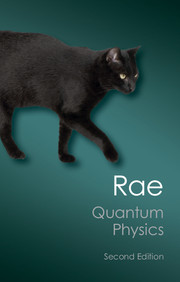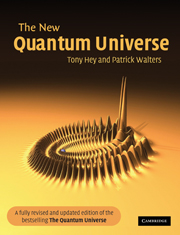Refine search
Actions for selected content:
3361 results in Quantum Physics, Quantum Information and Quantum Computation
9 - Dissipative coherent tunneling
-
- Book:
- An Introduction to Macroscopic Quantum Phenomena and Quantum Dissipation
- Published online:
- 05 April 2014
- Print publication:
- 20 March 2014, pp 205-221
-
- Chapter
- Export citation
3 - Elements of superconductivity
-
- Book:
- An Introduction to Macroscopic Quantum Phenomena and Quantum Dissipation
- Published online:
- 05 April 2014
- Print publication:
- 20 March 2014, pp 46-86
-
- Chapter
- Export citation
4 - Brownian motion
-
- Book:
- An Introduction to Macroscopic Quantum Phenomena and Quantum Dissipation
- Published online:
- 05 April 2014
- Print publication:
- 20 March 2014, pp 87-103
-
- Chapter
- Export citation
7 - The damped harmonic oscillator
-
- Book:
- An Introduction to Macroscopic Quantum Phenomena and Quantum Dissipation
- Published online:
- 05 April 2014
- Print publication:
- 20 March 2014, pp 151-166
-
- Chapter
- Export citation
Preface
-
- Book:
- An Introduction to Macroscopic Quantum Phenomena and Quantum Dissipation
- Published online:
- 05 April 2014
- Print publication:
- 20 March 2014, pp xi-xiii
-
- Chapter
- Export citation

Quantum Physics
- Illusion or Reality?
-
- Published online:
- 05 February 2014
- Print publication:
- 26 March 2012

The New Quantum Universe
-
- Published online:
- 05 October 2013
- Print publication:
- 23 October 2003
18 - Fault-tolerant measurement-based quantum computing
- from Part V - Alternative quantum computation approaches
-
-
- Book:
- Quantum Error Correction
- Published online:
- 05 September 2013
- Print publication:
- 12 September 2013, pp 432-452
-
- Chapter
- Export citation
7 - Entanglement-assisted quantum error-correcting codes
- from Part II - Generalized approaches to quantum error correction
-
-
- Book:
- Quantum Error Correction
- Published online:
- 05 September 2013
- Print publication:
- 12 September 2013, pp 181-200
-
- Chapter
- Export citation
21 - Experimental quantum error correction
- from Part VII - Applications and implementations
-
-
- Book:
- Quantum Error Correction
- Published online:
- 05 September 2013
- Print publication:
- 12 September 2013, pp 509-518
-
- Chapter
- Export citation
Part VIII - Critical evaluation of fault tolerance
-
- Book:
- Quantum Error Correction
- Published online:
- 05 September 2013
- Print publication:
- 12 September 2013, pp 583-584
-
- Chapter
- Export citation
1 - Introduction to decoherence and noise in open quantum systems
- from Part I - Background
-
-
- Book:
- Quantum Error Correction
- Published online:
- 05 September 2013
- Print publication:
- 12 September 2013, pp 3-45
-
- Chapter
- Export citation
Index
-
- Book:
- Quantum Error Correction
- Published online:
- 05 September 2013
- Print publication:
- 12 September 2013, pp 657-666
-
- Chapter
- Export citation
2 - Introduction to quantum error correction
- from Part I - Background
-
-
- Book:
- Quantum Error Correction
- Published online:
- 05 September 2013
- Print publication:
- 12 September 2013, pp 46-77
-
- Chapter
- Export citation
References
-
- Book:
- Quantum Error Correction
- Published online:
- 05 September 2013
- Print publication:
- 12 September 2013, pp 625-656
-
- Chapter
- Export citation
26 - Critique of fault-tolerant quantum information processing
- from Part VIII - Critical evaluation of fault tolerance
-
-
- Book:
- Quantum Error Correction
- Published online:
- 05 September 2013
- Print publication:
- 12 September 2013, pp 612-624
-
- Chapter
- Export citation
6 - Operator quantum error correction
- from Part II - Generalized approaches to quantum error correction
-
-
- Book:
- Quantum Error Correction
- Published online:
- 05 September 2013
- Print publication:
- 12 September 2013, pp 163-180
-
- Chapter
- Export citation
Part VI - Topological methods
-
- Book:
- Quantum Error Correction
- Published online:
- 05 September 2013
- Print publication:
- 12 September 2013, pp 453-454
-
- Chapter
- Export citation
12 - Algebraic quantum coding theory
- from Part III - Advanced quantum codes
-
-
- Book:
- Quantum Error Correction
- Published online:
- 05 September 2013
- Print publication:
- 12 September 2013, pp 307-326
-
- Chapter
- Export citation
Frontmatter
-
- Book:
- Quantum Error Correction
- Published online:
- 05 September 2013
- Print publication:
- 12 September 2013, pp i-iv
-
- Chapter
- Export citation
